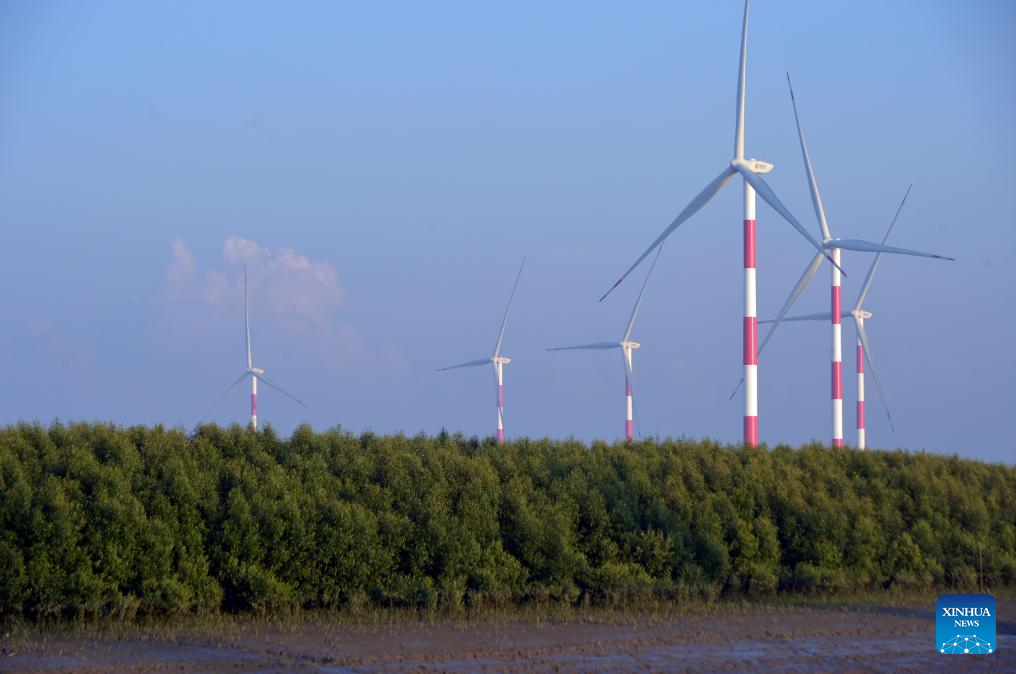Khurushkul, once a small village in Bangladesh’s Cox’s Bazar district, some 400 km southeast of the capital Dhaka, boasts Bangladesh’s first wind power plant built by a Chinese company.
The plant, a large-scale centralized wind power plant with 22 wind turbines with a single capacity of 3 megawatts (MW) installed, has started operation, facilitating the South Asian country’s energy transition and green development.

Last month, Bangladesh joined the global wind power club with the inauguration of its Cox’s Bazar wind power project.
The wind power project is invested by Wuling Power Corp., a subsidiary of China’s State Power Investment Corp. (SPIC), and built by PowerChina Chengdu Engineering Corp.
Upon its full operation, the project will provide Bangladesh with about 145 million kWh of clean electricity per year, reduce coal consumption by 44,600 tons and carbon dioxide emissions by 109,200 tons, as well as meet the electricity demand of 100,000 households.
Bangladeshi engineer Abdullah Arif, who graduated from a Chinese university, is working as an operation shift in-charge in the plant.
“After graduation, I joined this project. From here we can learn and serve our country for the renewable energy and we can improve our electricity demand,” Arif told Xinhua.
He said the plant now feeds 30 MW of electricity into the national grid and will run at the full capacity by the end of year.
Out of the 22 turbines of this project, he said, they have installed 10 turbines with a capacity of 30 MW.
“We can expect at the end of this year, we can install the remaining 12 turbines of this project, produce 60 MW in total, and transfer it to the national grid,” he added.
Arif expressed his hope that Bangladesh can develop a huge generation capacity in renewable energy in the future. “Because electricity is one of the top priorities in building a developed country.”
“It will help improve my country’s environment,” said Arif, explaining that wind is definitely a green energy that can help reduce Bangladesh’s carbon emissions.
Yin Bobo, director of the Cox’s Bazar Wind Power Plant, said the project has customized the “China Plan” for Bangladesh, coming up with site-specific solutions for the coastal areas featured by frequent tropical cyclone disasters, poor alluvial plain geological foundation, and low average wind speed.
During the construction of the project, more than 1,500 jobs were provided for the locals, said Yin, adding that the current eight operation and maintenance employees of the power plant have received strict and systematic wind power technology training.
Yin said Wuling will continue to focus on the development of green energy and assist Bangladesh in its low-carbon energy transformation in realizing the dream of “Golden Bangladesh” at an early date.
“It’s a major watershed in our nation’s journey towards cleaner and more sustainable energy,” said Habibur Rahman, senior secretary of Power Division under Bangladesh’s Ministry of Power, Energy and Mineral Resources, when addressing the launching ceremony last month.
This project will not only provide clean electricity to thousands of households, but also help reduce Bangladesh’s reliance on fossil fuels. It will also have a positive impact on the country’s environment and air quality, and mitigate the effects of climate change, the official noted.
“The successful operation of this project marks a new era for the wind power industry in Bangladesh,” Jashim Uddin, Bangladeshi Ambassador to China, said via video link.
“The historic introduction of wind power by Chinese enterprises to Bangladesh marks a milestone of bilateral cooperation in new energy sector,” Chinese Ambassador to Bangladesh Yao Wen noted, stressing that China stands ready to help Bangladesh develop new energy.

